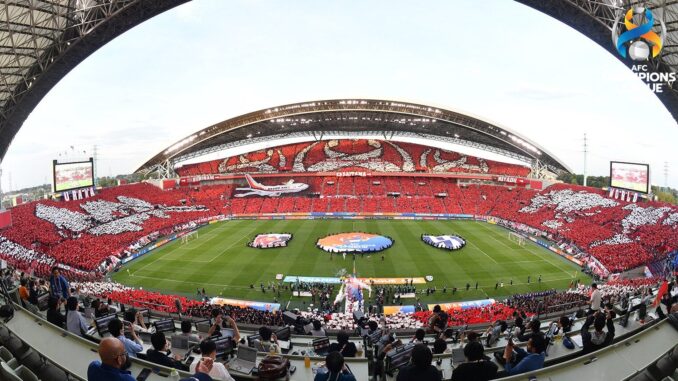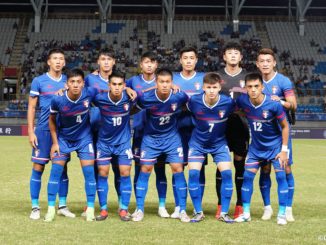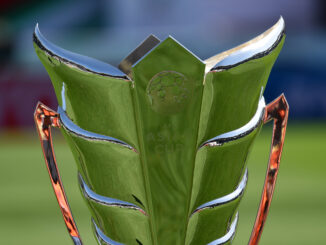
Have you ever seen a Tifo quite like it?
The fans of Urawa Red Diamonds are known across the continent, in fact probably across the world, for their full stadium Tifo efforts at previous AFC Champions League finals.
But this year they outdid themselves.
Turning the stadium into a sea of red, at one end under giant letters spelling ‘U R A W A’ a plane, dubbed ‘Urawa Air’, was moved along the grandstand to signify the team’s journey throughout the competition.
There were signposts signifying each step along the journey: Buriram, Saitama and then Riyadh.
It ended with with the plane finishing at the other end of the stadium under giant letters spelling ‘W O R L D’ with the tifo containing a world map, signifying what they hoped to be their journey to the FIFA Club World Cup.
It was a jaw dropping moment of choreography, but one we have come to expect from Urawa who seem to set the bar higher and higher with each AFC Champions League final they host.
They are scenes that travel around the world, shining a much needed light on the club game in Asia.
Just a week earlier we witnessed equally impressive scenes in Riyadh when Al Hilal fans turned the iconic King Fahd Stadium into their own giant canvas; first with a display spelling out ‘Go Blues’ which then morphed into a display of a person ripping open their shirt to display a blue chest featuring Al Hilal’s logo.
They are scenes that defy a perception of the AFC Champions League being a tournament that lacks interest and passion; a competition that some see that lacks a soul.
There was plenty of heart and soul on display in Riyadh and Saitama over the past two weeks, as there has been in any number of finals across the years – from Seoul to Sydney, Guangzhou to Tehran and Al Ain to Jeonju.
Loud. Passionate. Parochial. They should be the foundation stones for the AFC Champions League.
That those scenes came at the end of a torturous campaign, throughout which we had to endure the soul-sucking bubbles and neutral venues that were usually accompanied by a backdrop of empty seats, an understandable necessity as COVID lingered, only stood to magnify how important they are for the health of the entire tournament.
No one wants to watch football played in front of largely empty stands, or even stands that are filled with neutrals with no skin in the game. It is the very antithesis of the football experience administrators around the world crave and why they were desperate to get fans back into the stadium at the first opportunity post-COVID.
And yet, if the AFC has its way, the scenes we saw in Saitama and Riyadh, repeated across the continent over the past two decades, will largely be a thing of the past.
As part of their long overdue reforms to Asia’s continental club competitions, the structure of the knockout rounds of the AFC Champions League will be flipped on its head.
While the AFC will, at long last, do away with the needless splitting of the tournament along East/West lines, bringing both sides of the continent together from the quarter finals stage, they are doing so at the expense of the type of atmosphere and experience we saw over the past fortnight.
The plan, as it stands, is that the reformed competition, due to begin in 2024/25, will have the entire knockout stage played at a centralised venue. That is quarter finals, semi finals and final all in one city in the space of a week.
Expect the usual suspects to be the ones to put their hands up to host such occasions – Qatar, China, Saudi Arabia, Japan and perhaps UAE and Korea.
While you may get lucky and have a team from one or two from those nations, or cities, reach the pointy end, you would still be guaranteed a number of neutral games.
The AFC has trialed neutral venues before, when the Final was held in Tokyo in 2009 and 2010, and while both games had about 25,000 in attendance, in a 50,000 seat stadium, it lacked the soul and atmosphere you would want from a final.
After two years it was rightly scrapped for a return to proper home finals.
What is also lost is the natural tension and excitement that builds towards the end of the tournament.
While in theory the prospect of all the finals being played in quick succession sounds enticing, there is a beauty in the build up to a major knockout game. There are fluctuations of form, fitness and injuries.
Anticipation and excitement builds and develops naturally over days and weeks. With only two or three day breaks between games, all sense of excitement and anticipation will be lost.
So fast will the games come that it won’t allow for storylines to develop, for tension to build and for excitement to reach fever pitch.
Imagine for a moment, Buriram United of Thailand make it through and are drawn to play, let’s say, Pakhtakor in the quarter final… and the game takes place in Jeddah.
Both sets of fans will be denied the unique opportunity to witness their side in such an important match. Games that would normally be played against a backdrop of full stadiums would instead be played in front of the reverse.
We know because we have the experience of this to inform us.
Al Shabab against Nasaf Qarsi was attended by just 700 fans in Qatar. BG Pathum United taking on Kitchee saw only 258 turn up in Japan. Even when two teams from the host nation were involved, the attendance still wasn’t mindblowing.
Only 700 turned up when Al Duhail hosted fellow Qatari side Al Rayyan, while 11,528 made the trek to Saitama when Yokohama F.Marinos ‘hosted’ Vissel Kobe.
No one wants that.
Not the players, the clubs, the fans or, importantly, the broadcasters.
These matches should be the pinnacle of Asian club football, showcasing the passion, cultures and football that make it so unique. The broadcasters want the best possible product, that is why they pay what they do. If AFC want them to pay more, as they obviously do, they need to make the product better.
That is more knockout matches. More full stadiums. More incredible passion, noise, and colour. More of what makes Asian football so great.
There were plenty of issues with the structure of the AFC’s club competitions that needed fixing. The format and location of the finals wasn’t one of them.
If it ain’t broke, don’t fix it.
Photo: twitter/TheAFCCL
Listen to The Asian Game Podcast LIVE from Saitama Stadium for the AFC Champions League Final




